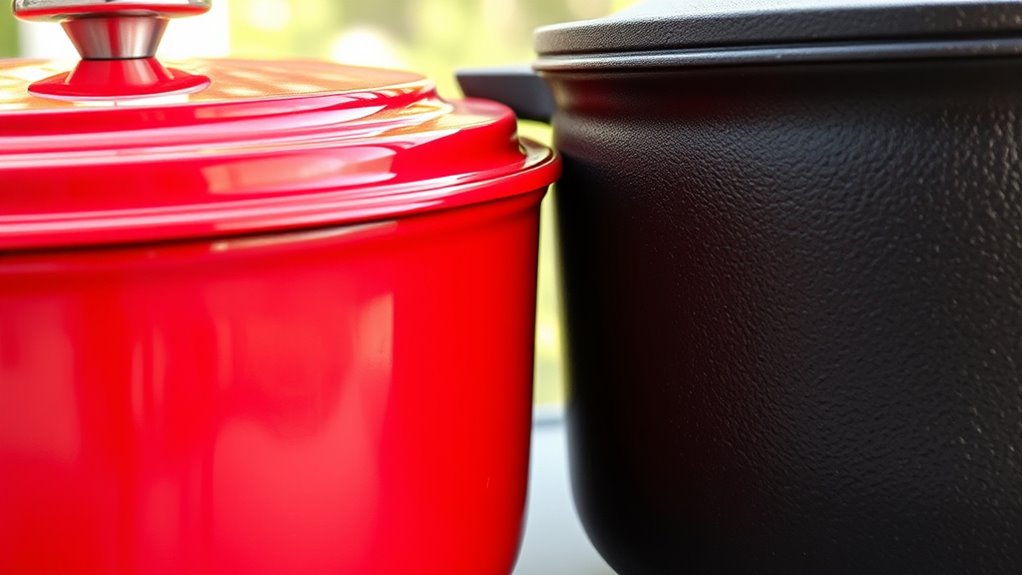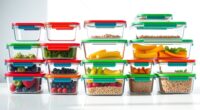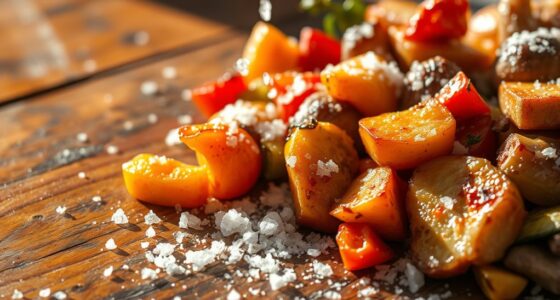Enameled cast iron Dutch ovens look vibrant and are low-maintenance, resisting rust and chipping if handled carefully, but can crack over time and are pricier. Raw cast iron offers rugged durability, excellent heat retention, and affordability, but requires regular seasoning and careful cleaning. Your choice depends on your style and upkeep preferences. To understand how each options performs in your kitchen, explore the details further.
Key Takeaways
- Enameled cast iron offers vibrant colors, easy maintenance, and resistance to rust, while raw cast iron provides a rugged look and develops a patina over time.
- Enameled Dutch ovens require less upkeep, don’t need seasoning, but can chip; raw cast iron needs seasoning and careful handling to prevent rust.
- Raw cast iron heats slowly but retains heat well, ideal for high-temperature cooking; enameled versions conduct heat evenly with easier cleaning.
- Enameled cookware is more expensive upfront but lasts decades with proper care; raw cast iron is more affordable but may need replacement sooner.
- Both types are versatile, but enameled models are safer and suitable for oven use, whereas raw cast iron excels in high-heat and long-cooking applications.
Material Composition and Aesthetic Appeal
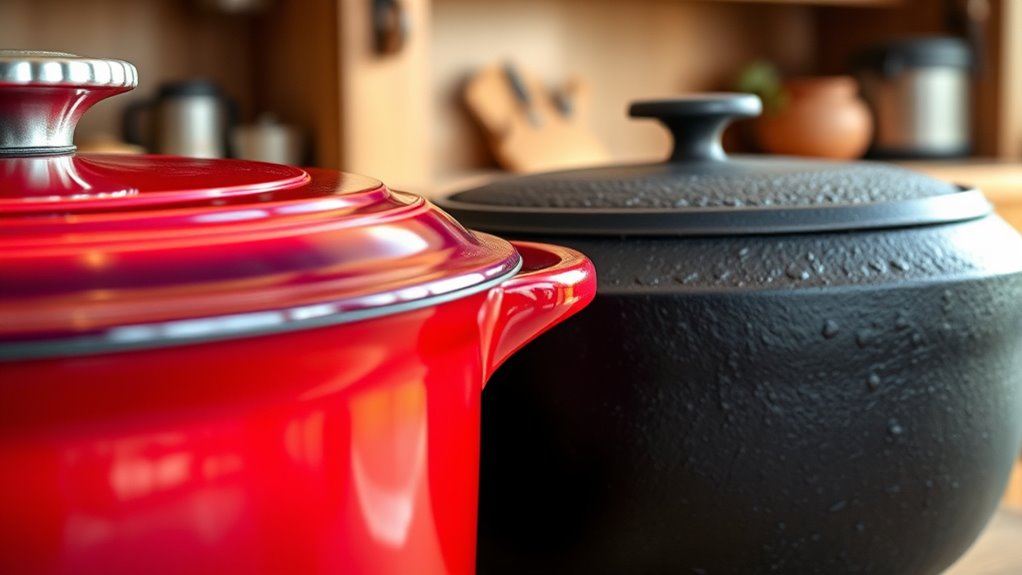
When choosing between enameled and raw cast iron Dutch ovens, your decision often hinges on their material composition and appearance. Enameled cast iron features a vitreous enamel coating, made from glass particles fused to the iron, creating a smooth, glossy finish that resists staining and rust. This coating allows for vibrant colors and polished looks, enhancing aesthetic appeal and complementing your kitchen decor. Raw cast iron, on the other hand, has a natural, matte surface that emphasizes durability and a classic, utilitarian appearance. Over time, raw cast iron develops a patina, adding character, whereas enameled versions maintain their glossy look with proper care. Your choice depends on whether you prefer the colorful, polished look of enameled cast iron or the rugged, traditional charm of raw cast iron.
Maintenance and Durability Considerations
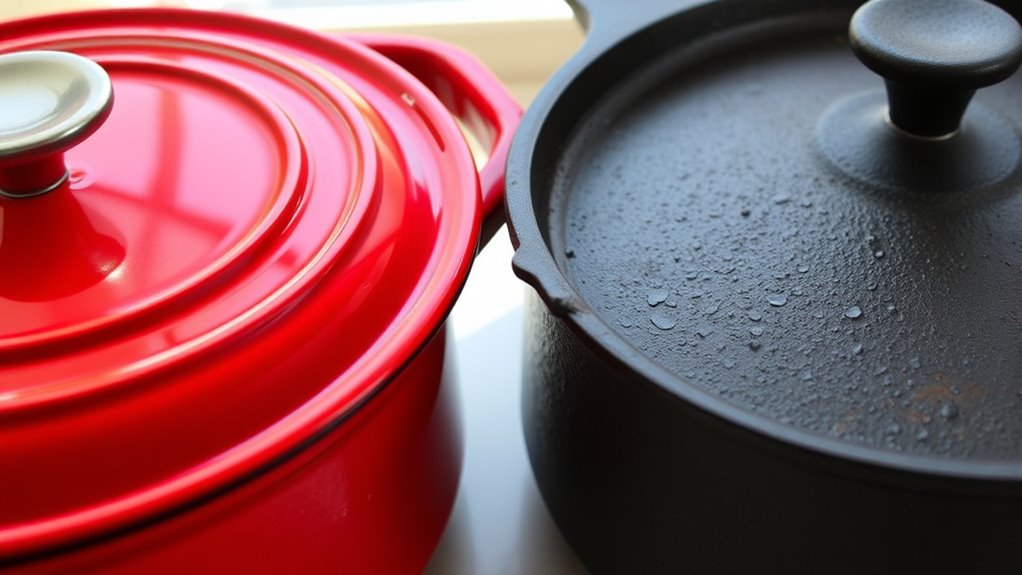
Choosing between enameled and raw cast iron Dutch ovens involves considering how you’ll maintain and protect them over time. Enameled cast iron requires less maintenance since it doesn’t need seasoning and is dishwasher safe, making cleanup easier. Its durability against rust is higher because the enamel resists corrosion, but chipping or cracking can occur if mishandled, which may shorten its lifespan. Raw cast iron demands regular seasoning and careful hand washing to prevent rust, but it’s virtually indestructible if properly cared for. Both types benefit from proper care—drying thoroughly, avoiding harsh abrasives, and applying oil to cast iron. While enameled models can chip, they typically last many years; seasoned cast iron can often be restored even after rust or damage, ensuring long-term durability. Additionally, understanding wicks and fragrance oils can enhance the longevity and performance of your cast iron cookware.
Performance in Cooking and Heat Retention

Cast iron Dutch ovens are renowned for their excellent heat retention, ensuring your dishes cook evenly and thoroughly. This high heat retention provides consistent temperature stability during slow heating, making them ideal for braising and roasting. Raw cast iron heats slowly but distributes heat evenly, promoting superior heat conduction and reducing hot spots. Proper seasoning of raw cast iron also plays a significant role in enhancing its non-stick surface and overall heat efficiency. Enameled Dutch ovens conduct heat similarly but may slightly decrease heat retention due to the insulating enamel layer. Their heat transfer efficiency can vary, sometimes causing minor hot spots if the enamel isn’t of high quality. Both types excel in high-temperature cooking, but raw cast iron generally offers better performance for tasks requiring sustained, even heat, enhancing overall cooking performance. This balance of heat distribution and stability ultimately influences your results in the kitchen. Additionally, material properties can impact heat retention and transfer, which is also important in selecting cookware for specific cooking techniques. Understanding thermal conductivity helps in choosing the right type for different culinary needs.
Handling, Safety, and Usage Flexibility

Enameled Dutch ovens are generally safer and easier to handle because they don’t require seasoning and are resistant to rust, making them suitable for a variety of cooks. With enameled cookware, handling is straightforward, and safety is enhanced since you can use metal utensils without damaging the surface. Their rust prevention qualities mean less maintenance and worry about corrosion. While enameled versions excel in oven safety and can handle high temperatures, they’re not ideal for open flames or grilling. Usage flexibility is broad, but sudden temperature changes should be avoided to prevent cracking. Proper handling, such as using appropriate utensils and avoiding rapid temperature shifts, extends the lifespan of both enameled and raw cast iron cookware, ensuring safe and versatile kitchen use. Additionally, understanding the design features of enameled versus raw cast iron can help in selecting the right piece for your cooking needs. Being aware of the material durability of each type can further assist in making an informed choice. For example, seasoning is unnecessary with enameled cookware but essential for raw cast iron to develop a natural non-stick coating. Recognizing the maintenance requirements of each type can help maintain their performance and longevity over time. Furthermore, the exfoliating properties of glycolic acid can improve skin texture and clarity, making it a popular choice in skincare routines.
Cost, Warranty, and Long-Term Investment
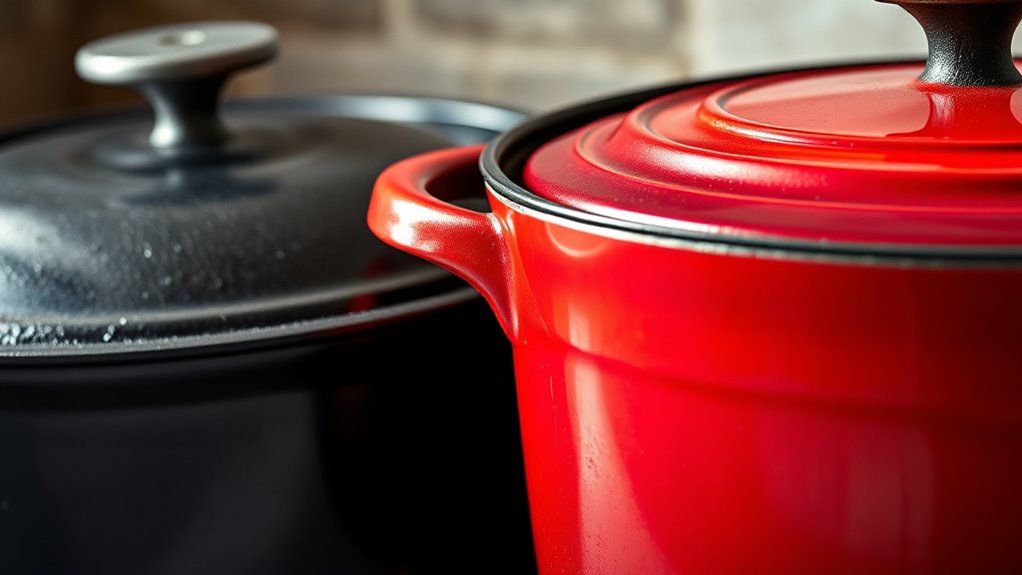
While enameled Dutch ovens often come with a higher upfront cost, their durability and long-term warranty can make them a worthwhile investment. Their price point ranges from $150 to over $400, reflecting quality, brand reputation, and longevity. In contrast, raw cast iron models are more budget-friendly, costing between $25 and $100, but may require replacement sooner if not properly maintained. An enameled Dutch oven’s lifespan can extend for decades with proper care, though enamel chipping or cracking can reduce its lifespan and resale value. Proper care is essential to maintain their appearance and functionality over time. Additionally, material properties influence how each type responds to everyday use and maintenance. The warranty options offered by manufacturers can also impact the overall value and peace of mind for consumers. Proper understanding of long-term investment benefits can help buyers choose the best option for their needs.
Frequently Asked Questions
Should I Get Enamel or Cast Iron in the Dutch Oven?
You’re wondering whether to get an enameled or raw cast iron Dutch oven. Think about your cooking habits—if you want something low-maintenance and attractive, go for enameled, which cleans easily and resists rust. But if you need durability, high heat, and outdoor versatility, cast iron is the way to go. Consider your budget and how much care you’re willing to give, then choose accordingly.
Which Is Better, Plain Cast Iron or Enameled Cast Iron?
When choosing between plain cast iron and enameled cast iron, it depends on what you value most. If you want durability, longevity, and outdoor versatility, plain cast iron is better, especially since it develops a natural nonstick surface over time. If you prefer easy cleaning and less maintenance for indoor use, enameled cast iron suits you better. Consider your cooking style and maintenance preferences to decide which suits you best.
What Are the Disadvantages of Enameled Cast Iron Pans?
You should know that enameled cast iron pans have some drawbacks. They can chip or crack if dropped or handled roughly, especially around the edges or during stacking. The enamel may stain or discolor over time, and chipped enamel can flake into your food, raising health concerns. Also, using metal utensils or sudden temperature changes can damage the surface, and once chipped, it can’t be repaired, reducing the pan’s lifespan.
What Cannot Be Cooked in Enameled Cast Iron?
You can’t cook certain substances in enameled cast iron, especially those that can crack or chip the coating. Avoid grilling, open-flame cooking, and broiling at high temperatures above 500°F. Steer clear of acidic foods like tomato sauces and citrus for long periods, as they can damage the enamel. Also, don’t use metal utensils or expose the pot to sudden temperature shifts, which can cause cracking or chipping.
Conclusion
Now that you know the pros and cons of enameled versus raw cast iron, the choice isn’t straightforward. Imagine yourself confidently cooking hearty stews or baking crusty bread, knowing your oven’s material can handle anything you throw at it. But which will stand the test of time and your kitchen adventures? The decision hinges on what matters most to you—durability, maintenance, or cost. Whichever you choose, your culinary journey is about to get a whole lot more exciting.
